The birth of a legendary Japanese band. This is where it all began: Lamp’s first release, 2003’s Soyokaze Apartment 201. I have translated below two interviews pertaining to the album, as well as Someya Taiyo’s liner notes for all of the tracks.
The first interview was originally published on WebVANDA.
Original interview & text: Uchi Takahide (original interview)
English translation: Henkka
Lamp online: website, label, blog, Facebook, Twitter, Spotify, YouTube, SoundCloud, Instagram
You can buy Lamp’s music directly from the band, both physically and digitally, on Bandcamp.
This group of three men and women known as Lamp debuted in April 2003. Whenever I listen to their young, lively sound, I’m always brought back to the season of the blazing sun…
In this interview, we talked to the band about their origins and about the making of this album.
— First, could you tell us about how Lamp was first formed?
Someya Taiyo: I’d known Nagai (vocals & bass) for a long time — he was a year below me in high school. We first met at our school’s Folk Song Association where we hit it off after we learned that we both liked The Beatles, and so we decided to do something together. Another big thing for me was when I discovered bossa nova music in February of 2000. I found that it was a genre that had so much of what I was looking for in music.
— Who was the artist that got you hooked?
Someya: Joao Gilberto. I borrowed some of his music from a friend. It was actually something on an Astrud Gilberto best-of album — I think it was Joao’s live cover of “The Girl From Ipanema” or something.
— The song by Tom Jobim, right? That’s pretty much one of those tried and true songs for someone to get totally addicted to bossa nova.
Someya: That’s right. I still remember when I first heard it. That lingering chord progression and the way it connects to the melody just really left an impression on me — I’m more drawn into harmonies rather than the rhythm when it comes to bossa nova. It was around that time when I was at a high school friend’s house and I asked him if he knew anyone who might like this type of music, and he introduced me to Sakakibara. It turned out that she could even play the accordion and the flute, and right away it felt like she was the right fit.
Once I got into university I started listening to all kinds of soft music, although even back in high school I did already like the Beatles, Simon & Garfunkel, and other pop. But a friend of mine lent me all the soft rock essentials and such, beginning with the Beach Boys and Roger Nichols. That gradually led to my “awakening.”
— So while Lamp has a bossa nova foundation, do you hope to incorporate those soft rock harmonies in your music as well?
Someya: Yes. Recently we’ve finally figured out how we want to sound.
— Next, I’d like to ask about your roles within the group. Do you try to make the best out of your individual abilities? How do you decide on who does the harmony vocals, for instance?
Someya: On this album many of the harmony vocals were done by Nagai. Although Kaori did quite a few, too…
— Is it mostly that Nagai sings lead on his own songs while Sakakibara sings lead on your songs?
Someya: We wouldn’t have good balance if we didn’t do that. If Nagai also sang the songs that I write, then there’d be nothing left for Kaori to sing. Recently we’ve been thinking about having Kaori sing on some of Nagai’s songs though.
— I see. So basically, when you’re writing a song you’re doing so on the premise that it’s going to be sung by Sakakibara — almost like an author writing songs for somebody else.
Someya: This ties into what we were just talking about. I try to write my lyrics from pretty much a female perspective, which can create some rather difficult constraints for me. When I listen to Nagai’s songs, I think about how it’d be pointless for me to write something that sounds exactly like that. With our next album I already feel like I need to write songs that are more and more different from his, just for the sake of variety.
— In other words, you’re like the “balancer” of the group. How long did it take you to record your debut album?
Someya: The recordings took place from mid-September to the end of October, so about two [sic] and a half months. We were planning on releasing it sooner, but we had to push it back due to various circumstances.
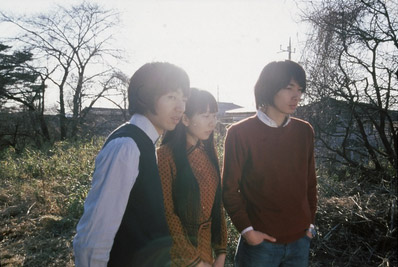
— Next, I’d like to ask you about the conception and motifs behind the songs themselves. First: “Machi wa Amefuri.” When I first heard this song it really reminded me of neo soul, especially in the key change at the transition between the second verse and the chorus.
Someya: For me, when I do key changes it can happen in one of two ways: either through thinking about it logically, or through pure accident. It’s either… For example, I might think of doing an Ivan Lins-esque key change and I’ll do so deliberately, or I might first come up with a pre-chorus melody or something and I just end up having a key change there by accident. In that case, I have to sing it and try to figure out the chords to fit the melody.
— It’s the harmony of those chords during the key change that’s so neo soul-like to me, so I’m guessing that maybe in this song it was the former — Ivan Lins, aka “the Stevie Wonder of Brazil.” That’s such a distinctive chord progression, I could listen to it over and over again and just never get bored. That might be one of the key characteristics of Lamp.
Someya: It’s something I try to aim for. How should I put it…? I never have just one song as a motif, but rather I try to cram influences from like five or six recent favorites into my compositions. With this song it’s not that I specifically tried to copy Ivan, but I just wanted to try doing a key change like that.
— It’s like you’re only incorporating your impression of any given music, right? That’s what comes out in the songs you write. Is this song possibly one of your personal favorites?
Someya: Yes. Or, well, I feel it’s more that I just… I wrote the song as I always would. But people tell me it’s good when we play it live, so I’m happy about those reactions.
— I want to mention the lyrics, too. They’re so mature; so poetic.
Someya: If you were to ask me what the inspiration for that was, I might answer that it was the manga works of artists like Tsuge Yoshiharu — like, trying to see just how well I could express the atmosphere of those manga in just words. Well, I’m not sure if I was thinking about it that deeply though.
— Next: “Konya no Futari.” Now this just reminds me so much of artists like SUGAR BABE and Ito Ginji. Were they an inspiration?
Nagai Yusuke: I was originally thinking of doing this song with a more rock-oriented band — I intended it to sound a bit more distorted. But then that band ended, and I was at Someya’s house playing the song on the guitar in a more folky way when suddenly we started talking about doing the song with Lamp. He ended up doing most of the arrangement. I wasn’t expressly thinking about SUGAR BABE though, no.
— So it just ended up sounding like that? Those elements just naturally find their way into your music?
Someya: Right. The songs we like just end up getting in there.
Nagai: Yeah. Since it’s us doing it, we can’t help but make it sound similar to what we like.
Someya: If it wasn’t something similar to what we liked, we wouldn’t want to do it.
Nagai: We still haven’t been able to properly communicate our S&G influences though…
Someya: Well, maybe not directly. But indirectly, I do feel like there’s some Paul Simon influence in our lyrics. I love the lyrics to “For Emily, Whenever I May Find Her,” for example. But you can’t hear that even if you tried to.
— It might be one of your underlying influences. I’d also like to ask Sakakibara a question. What was the song that you most struggled with as a vocalist? “Machi wa Amefuri,” perhaps?
Sakakibara Kaori: Yes. It’d have to be that one.
Someya: Didn’t you get done with recording it pretty quickly though?
Sakakibara: I’m someone who always finishes recording my vocals quickly. It doesn’t take me a long time. The very first take is usually no good, but two or three takes is usually all it takes. Any longer than that, I start to dislike doing it and it just tires me out.
— I see. By the way, which studio did you use to record the album?
Sakakibara: It was the house of our recording engineer. Like, with Japanese-style doors and sliding screens…
Nagai: The people reading this probably won’t even be able to picture it. It’s seriously just an average, Japanese-style house. It’s not like our recording engineer is a recluse or anything, but there really just aren’t other houses nearby. I mean, it’d be a huge nuisance to those neighbors if there were. (laughs) There’s seriously like a drum set right there on top of his tatami mat!
Someya & Sakakibara: (laughs)
— Wow, what a recording environment! (laughs) That’s in the realm of things like the 70s Woodstock Sound and Hosono House. Thank you very much for sharing all these valuable stories today.
The second interview was posted on a website called cameco which no longer exists. (It was later re-posted on Lamp’s blog 10 years after the release of the album.)
Original interview & text: Nagasawa Tomonori (original interview)
English translation: Henkka
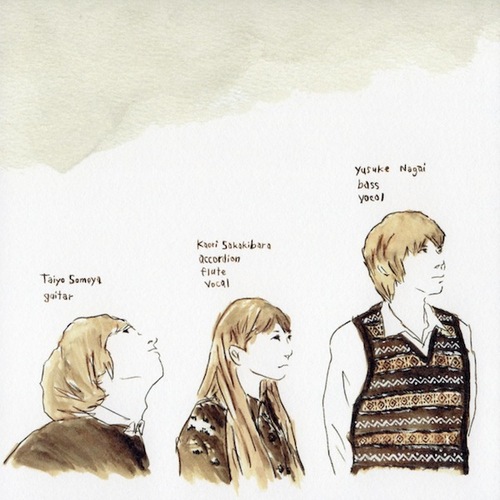
— Lamp builds a very pleasant musical landscape, mixing a refreshing, pop-influenced sound with bossa nova rhythms and harmonies to great effect. Was bossa nova — the cornerstone of your sound — always a big musical influence for you?
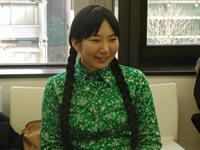 Sakakibara: We originally started off doing really simple bossa nova so in that sense I would say it’s a big part of our sound, yes.
Sakakibara: We originally started off doing really simple bossa nova so in that sense I would say it’s a big part of our sound, yes.
Someya: Right. In the beginning we were just doing bossa nova with the voices of these two (Nagai & Sakakibara) along with an acoustic guitar in the background, playing as quietly as possible. But then we started going in a more pop direction… Or rather, we began thinking how it might be important to make music that could perhaps get listened to by more people. So we’ve become more pop as of late.
— Speaking on the topic of pop: yours is a very “friendly” kind of pop, with refreshing melodies, bossa rhythms, harmonies, but also with some French and soul influences. You have such a great feel for choosing and mixing those diverse musical elements. You’re like five-star chefs!
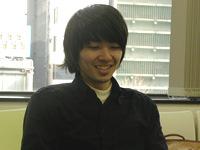 Nagai: That was only thanks to the many supporting musicians that were featured on the album. There’s no way we could’ve managed having all those elements in there if it’d been just us. I also think that something that really took our songs to the next level was us now being able to focus on those different musical elements in each song and decide what to keep and what to take out. All three of us have a tendency of cramming in too many sounds into the songs, so it’s difficult trying not to go overboard.
Nagai: That was only thanks to the many supporting musicians that were featured on the album. There’s no way we could’ve managed having all those elements in there if it’d been just us. I also think that something that really took our songs to the next level was us now being able to focus on those different musical elements in each song and decide what to keep and what to take out. All three of us have a tendency of cramming in too many sounds into the songs, so it’s difficult trying not to go overboard.
Sakakibara: Right. That’s true for both the sound arrangements and just that general feeling of balance. We’re always trying to maintain a good balance between the vocals and the music without it sounding all messy.
Someya: We started by first adding all kinds of different elements, and then gradually taking out all the ones that weren’t actually necessary. As a result, we were able to create songs where there’s space for vocals as well as more simple sounds, and both are prominent.
— Another part of Lamp’s appeal are your lyrics that feel almost like scenes in a movie in how they portray in a very aesthetic way those subtle changes of the heart, depending on the situation. One can tell just how romantic the both of you lyricists — Someya and Nagai — are.
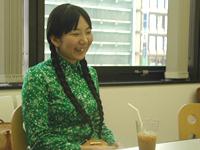 Sakakibara: Both of them write such heartrending lyrics, but Nagai’s lyrics are more youthful. Someya’s feel more… elderly. (laughs)
Sakakibara: Both of them write such heartrending lyrics, but Nagai’s lyrics are more youthful. Someya’s feel more… elderly. (laughs)
Someya: My lyrics aren’t elderly! (laughs) But in my case, because I really try to put everything that I feel particular about into my lyrics and my songs, that probably makes them very easy to understand.
Sakakibara: That’s true for the both of you. All the scenes you two talk about in your lyrics, they feel so like you. For instance, the first song on the album, “Kaze no Gogo ni” — that’s such a Nagai-like lyric!
— You’re a very inward-looking sort of romanticist, aren’t you, Nagai?
Nagai: I’m not the kind of person who could say anything about any one individual romantic experience of my own though. (laughs) Of course there are no lies in my lyrics, but they end up becoming so romantic that when I read them afterwards I’ll think to myself, “Oh, so this is the kind of thing I think about… This doesn’t sound anything like my usual self!”
— So it’s like you just unconsciously end up exposing your innermost feelings.
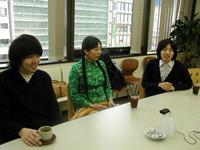 Nagai: I’m not clever enough to write about anything other than my personal feelings and things I’ve seen… So in that sense, yeah. I still have ways to go before I could just make up a story and write lyrics about that. (laughs)
Nagai: I’m not clever enough to write about anything other than my personal feelings and things I’ve seen… So in that sense, yeah. I still have ways to go before I could just make up a story and write lyrics about that. (laughs)
— Personally, I really like this expression from “Fuyu no Kissaten,” written by Someya: “sora ni shiro ga matte” (“white fluttering in the sky“). Your sense in using the word “white” instead of “snow” is so nice and poetic.
Someya: Oh no… That one…?
— Huh?!
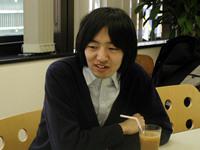 Someya: I wrote four of the songs on this album, but I have to say: that’s the one line which I don’t like. (laughs)
Someya: I wrote four of the songs on this album, but I have to say: that’s the one line which I don’t like. (laughs)
— What?! But it’s such a great expression!
Someya: Mmm… If you say so… (laughs)
— In listening to Soyokaze Apartment 201, I get the feeling that not only do you three share a strong musical connection, but also that you’re intuitively very similar to one another.
Someya: We definitely have quite a lot in common in terms of our mentality. I would actually say that rather than our musical connection, it’s that spiritual or ideological foundation that really ties us three together to where we can agree on what we want to do musically as well.
— I see. By the way, is it just me or does the title Soyokaze Apartment 201 not fit the musical scenery of the album?
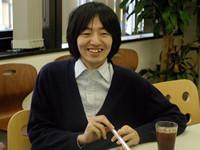 Someya: We were looking for a word that could summarize these six songs, and the word we came upon was “Soyokaze” (“Gentle Breeze”).
Someya: We were looking for a word that could summarize these six songs, and the word we came upon was “Soyokaze” (“Gentle Breeze”).
Sakakibara: Then we thought to also add the word “Apartment,” so we took out one of the songs we were initially planning on including and instead added the song “Heya no Madobe” (“Apartment Window“) at the end to emphasize the “apartment” bit.
— Oh, okay. Speaking of the lyrics, while the scenery in the lyrics is reminiscent of autumn and winter, the sound itself is rather more in the spirit of that lively spring or early summer season, isn’t it? It makes for such pleasant outdoors listening. In what sort of a setting do you think this album would best be listened to?
 Sakakibara: Rather than when you’re out on a trip somewhere, I think it’s better suited for just daily life. It feels so good to listen to it with all the windows of your house opened.
Sakakibara: Rather than when you’re out on a trip somewhere, I think it’s better suited for just daily life. It feels so good to listen to it with all the windows of your house opened.
Nagai: For me, since I wrote my songs with the image of Tokyo in mind, I hope people will listen to it while walking outside in the city somewhere.
Someya: Mmm… Maybe some fishing village out in the Hokuriku region.
— Huh? A Hokuriku fishing village?!
Someya: I’ve never actually been myself, but I happened to see some landscapes like that on TV and thinking to myself how well it fit the world of this album. (laughs)
Liner Notes
Lastly, Someya Taiyo’s liner notes for all six songs on the album, written in late 2004.
Original text: Someya Taiyo (parts one, two, three, four, five & six)
English translation: Henkka
1. “Kaze no Gogo ni” (music & lyrics: Nagai)
It was such a great feeling hearing this song for the first time.
The three of us — me, Nagai, and Kaori — were in my room when Nagai told us he’d written some new songs. I believe he then played us two of those new songs on an acoustic guitar, one of them being “Kaze no Gogo ni.”
The melody wasn’t yet finished and he pretty much just hummed the song to us, but it sounded so invigorating, being such a good representation of Nagai’s taste. When we actually decided to make our first album, I immediately thought to myself how it would be an album based around this song. It was the ideal, perfect first song for a new artist. One could directly hear in it the best of both Nagai and Kaori’s vocals — it’s like the song was meant for Lamp. I wasn’t expecting Nagai to write a song that was so “Lamp-like,” so I was very happy about it in many ways. Ultimately, I do think it was the right decision to place it as the first song of our first album.
In regards to the song itself, what impressed me the most about it was how it goes from the IVm7 chord, to the added 9th, and back to IM7 again… Just how pleasing it sounds when it does that. (This is in regards to the chord progression of the intro.) Most of Lamp’s previous songs featured only a repetition of the verse-chorus-verse pattern (even if on purpose), but this one had a proper bridge linking the verse to the chorus. This song was a clear first for us in that sense as well.
We had quite a bit of trouble recording this song. We weren’t completely happy with what we were able to record, but then that was also the limit of what we were capable of at the time. Nagai’s ideas for the piano phrases in the intro and the chorus harmonies, Kaori’s ideas for the flute phrases in the interlude — I like all of it. Also, near the end of the recording sessions we got LPchep3 — who have now disbanded — to add strings to it, and that really upped the scale of the song. It made it so complete. Lastly, it was my idea to have that scatting in the outro.
2. “Machi wa Amefuri” (music & lyrics: Someya)
This song brought on a big change for me as well as for Lamp.
I wrote it in June 2002 — right around that season of “rainy streets” (“machi wa amefuri“). I remember initially making the song on a classical guitar and adopting a bossa nova rhythm, but then thinking to myself how it might sound if played more in a band style. We then came to do it in the rhythm that can be heard on the recording.
I believe I wrote this song concurrently with “Natsu ni Chirashita Chiisana Koi.” I finished both around the same time, and the four or five of us — that’s including our supporting members at the time — went into the studio where we attempted doing these two songs. But when we tried “Natsu ni Chirashita Chiisana Koi,” Nagai told me that he had no idea how it ought to be arranged or how he should be playing on it. I, too, had trouble conveying to the others how I wished to arrange it. I just didn’t have a clear enough image of it. Conversely, when we tried doing “Machi wa Amefuri,” that one actually seemed to work.
Later in the summer of that year, we performed this song for the first time at Magnacy in Nishi-Azabu. At the time, we did so with just an acoustic guitar. Up until that point, even if we had at times performed originals, they were all songs in that bossa nova rhythm. And yet, this song was received surprisingly well. It definitely became one of the primary factors behind Lamp’s future direction. (Although that could also be said about Nagai’s “Ashita ni Nareba Boku wa” and “Konya no Futari” which were two songs that also didn’t feature bossa nova rhythms. However, at the time, we did not yet think of them as Lamp songs.)
I feel like the highlight of this song is the “sukoshi tsumetai kesa no kuuki…” bit. I’m very happy with how that part turned out. The lyrics and the atmosphere, sure, but especially the way the chords and the melody are entwined worked extremely well here. Recording-wise, it all comes down to Kaori’s vocals. Even though it was our first album and first time recording, her singing sounds so carefree. Personally, for the most part, I wasn’t really satisfied with our performances. But even with that in mind, I still think it to be a wonderful piece.
3. “Amaashi Hayaku” (music & lyrics: Someya)
This is the oldest Lamp song that we’ve released so far. I wrote it in June 2000.
It was written right around the same time as “Utakata Kitan.” Kaori really liked those two songs and I remember her praising them. At that point the two of us had only just met, so I was devoting myself to songwriting in order to build that musical trust between us. Since that was my mindset at the time, it made me very happy to receive her praise. Nagai, too, liked these two songs. As a person who doesn’t sing, I believe it was these two songs which really secured my position in the band.
To tell you the truth, I’ve never particularly liked the lyrics to “Amaashi Hayaku” ever since I first wrote them. The “yoru no ame ga…” passage alone is something I’m satisfied with, in terms of its lyrics, melody, and chord progression. That’s the one bit that I’ve been very fond of ever since I first wrote it.
Speaking about the recorded version, the members all unanimously agree that it’s the song we most wish we could re-record — that’s how displeased we are with it. But if you look at it from a different perspective, you might also take that to mean that it’s a song to which we all have a strong emotional attachment.
Initially, this song didn’t have that post-chorus bit before the interlude. But when we were recording Soyokaze Apartment 201 it seemed apparent that the song was lacking something, so I added that part. Looking back on it now, I feel like it might have been better and simpler without it.
4. “Konya no Futari” (music & lyrics: Nagai)
The three of us were gathered in my room just like always when Nagai played for us on an acoustic guitar his new song, “Konya no Futari.” His original vision of it was more folky — I still have the audio I recorded that day.
As Nagai was playing the song to us, he explained how there was a key change when going from the verse to the chorus, and then pointing out how there was a certain tension when going back to the original key of the verse again. I remember being impressed by that. Some days later, I got the idea of arranging it to a 16th beat rhythm and suggested it to Nagai. That is also when I came up with the phrase behind that guitar in the intro. The song originally didn’t have the bridge that follows the second chorus.
While it’s a simple song, I personally like the synthesizer phrases played by Ogata as well as the string melodies that the three of us — led by Kaori — came up with. I thought it was a great idea in the bridge for Nagai’s rhythm guitar to make use of the whammy bar. Nagai and me both came up with ideas for the guitar solo, but we decided to use mine.
5. “Fuyu no Kissaten” (music & lyrics: Someya)
Of all the songs I’ve written, this is one of the ones to which I don’t have much of an emotional attachment.
Thinking about the song, I remember now how I wrote it while trying to overlay the worldview in the works of Mutsu A-ko with that of my own. At the time, Kaori had half-forced me to borrow some of Mutsu A-ko’s manga from her, so I gave them a shot. It could thus be that it’s a rather “girly” kind of song, content-wise.
As for the song itself, I did try taking a rather ambitious approach to it in many ways, so I don’t mean to disparage it at all. Thanks to Yafune’s piano and organ playing, the performance and the sound of the song on the recording became so much more cohesive.
6. “Heya no Madobe” (music & lyrics: Someya)
The title Soyokaze Apartment 201 is something we came up with during the recording of the album, and I remember thinking how it would make the album even more “conceptual” if we put this song as the last track on the album. We had actually decided from the beginning to make it a six-song album, and in choosing the songs we were planning on including another song instead of this one. But as we came up with the title and started thinking more about the overall balance, we decided halfway to include this song.
At the time I was listening to a Marcos Valle album called Samba ’68, and I very much wanted to make a bossa nova album just like that one — an album of originals with not one throwaway song on it. This song, “Heya no Madobe,” was one of the songs I wrote as part of that project.
Personally, I like the way we used breaks in the verses, and also the contrasting chord progressions in the “kaze ga sukoshi zutsu…” and “kono omoi wa…” bits of the chorus. I also like how the third chord in the verse — the B79 — is held for longer than the other ones. We employed a synthesizer during the recording in an attempt to try and make it sound a bit fresher, but I don’t think it worked very well.
Conceptually, I’m personally very fond of “rooms” (“heya”) — these closed-off spaces. I feel I was able to successfully express that sort of a philosophical thought of mine with this song.
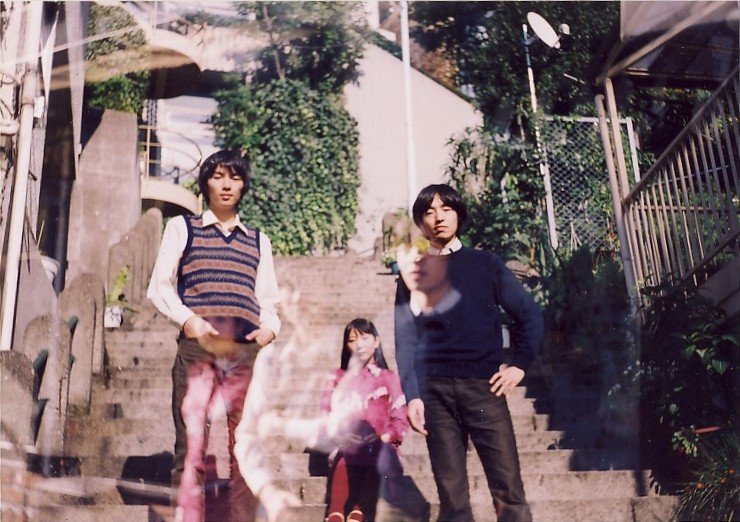
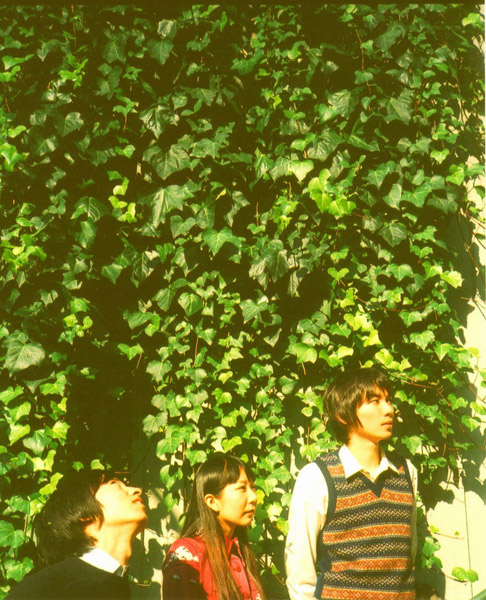
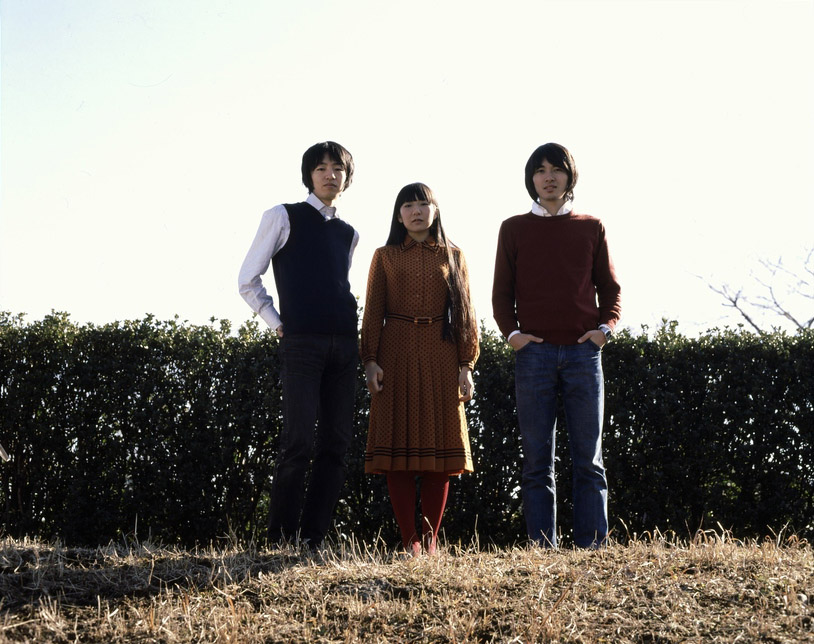

thanks for the translations! you’re doing god’s work
if i may suggest something — i think you might get more traffic on youtube if you are ever able to subtitle the interviews and songs (i’ve seen some interview on youtube before so there’s at least one)
I loved their translations very much, I’m a huge fan of the band, I was very satisfied, lengths from Brazil
Thanks Rafael. Lamp are huge fans of music from your country so they would be happy to hear you say that you’re a fan of theirs. Cheers!
Thank you so much for the translation. Reading their impressions is adding a whole another dimension of appreciation when I listen to this album. I had never thought of as a song as a “Someya song” or a “Nagai Song” but now I feel like I can connect to the feelings they poured into the writing more.
Hey Ben. Cheers. Yeah, it’s definitely an additional layer to enjoying Lamp — listening to the tunes to try and train your ear to figure out which of the two, Someya or Nagai, was responsible for the song in question.
And they’re both so goddamn good at what they do…